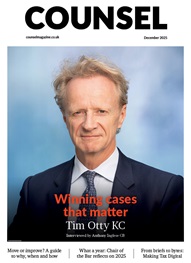*/
Two of the most senior judges expressed concern at the lack of diversity among judges.
‘Despite the leadership that has been demonstrated over the last year, progress is not as fast as we would wish,’ the Lord Chief Justice, Lord Thomas, and the Senior President of Tribunals, Sir Ernest Ryder, said in a statement accompanying the annual statistics for the make-up of the bench.
The figures showed that from April 2014 to April 2017, the percentage of female judges has increased from 18% to 24% in the Court of Appeal; 18% to 22% in the High Court and 24% to 28% in the courts judiciary.
While the percentage of black and minority ethnic (BAME) judges had increased from 6% to 7%, the judges said it was ‘disappointing’ that the percentage of non-barristers dropped from 37% to 34%.
In tribunals in the last four years the proportion of female judges rose from 43% to 45%, and the percentage of BAME judges increased from 9% to 10%, but the proportion of judges with a non-barrister background fell from 67% to 66% between 2015 and 2017.
The two senior judges said: ‘We remain very concerned about the slow recruitment of BAME judges and the downward trend of new non-barrister (solicitors and legal executives) judges, despite the dedicated work undertaken by the Judicial Diversity Committee.’
Two of the most senior judges expressed concern at the lack of diversity among judges.
‘Despite the leadership that has been demonstrated over the last year, progress is not as fast as we would wish,’ the Lord Chief Justice, Lord Thomas, and the Senior President of Tribunals, Sir Ernest Ryder, said in a statement accompanying the annual statistics for the make-up of the bench.
The figures showed that from April 2014 to April 2017, the percentage of female judges has increased from 18% to 24% in the Court of Appeal; 18% to 22% in the High Court and 24% to 28% in the courts judiciary.
While the percentage of black and minority ethnic (BAME) judges had increased from 6% to 7%, the judges said it was ‘disappointing’ that the percentage of non-barristers dropped from 37% to 34%.
In tribunals in the last four years the proportion of female judges rose from 43% to 45%, and the percentage of BAME judges increased from 9% to 10%, but the proportion of judges with a non-barrister background fell from 67% to 66% between 2015 and 2017.
The two senior judges said: ‘We remain very concerned about the slow recruitment of BAME judges and the downward trend of new non-barrister (solicitors and legal executives) judges, despite the dedicated work undertaken by the Judicial Diversity Committee.’


Chair of the Bar reflects on 2025
AlphaBiolabs has donated £500 to The Christie Charity through its Giving Back initiative, helping to support cancer care, treatment and research across Greater Manchester, Cheshire and further afield
Q&A with criminal barrister Nick Murphy, who moved to New Park Court Chambers on the North Eastern Circuit in search of a better work-life balance
Revolt Cycling in Holborn, London’s first sustainable fitness studio, invites barristers to join the revolution – turning pedal power into clean energy
Rachel Davenport, Co-founder and Director at AlphaBiolabs, reflects on how the company’s Giving Back ethos continues to make a difference to communities across the UK
By Marie Law, Director of Toxicology at AlphaBiolabs
Are you ready for the new way to do tax returns? David Southern KC explains the biggest change since HMRC launched self-assessment more than 30 years ago... and its impact on the Bar
Professor Dominic Regan and Seán Jones KC present their best buys for this holiday season
Marking one year since a Bar disciplinary tribunal dismissed all charges against her, Dr Charlotte Proudman discusses the experience, her formative years and next steps. Interview by Anthony Inglese CB
Little has changed since Burns v Burns . Cohabiting couples deserve better than to be left on the blasted heath with the existing witch’s brew for another four decades, argues Christopher Stirling
Pointillism, radical politics and social conscience. Review by Stephen Cragg KC